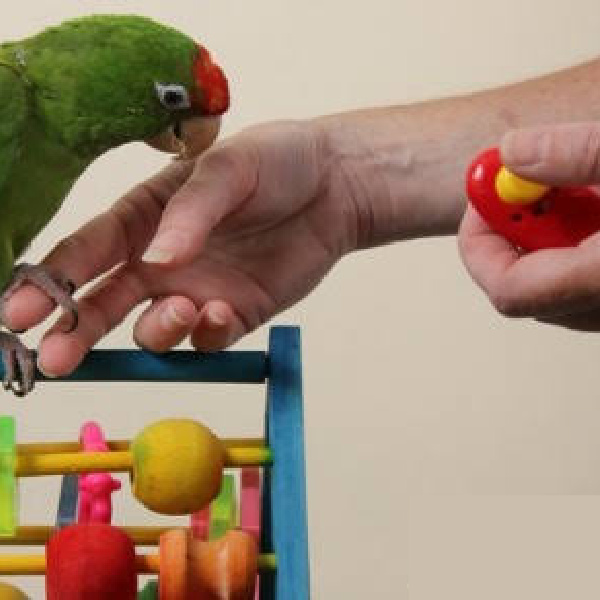Last Updated on by Mitch Rezman
Clicker training is a great way to teach your bird positive behavior. Clicker training is especially useful with problem birds and parrots because it can help in making positive changes with your birds.
Clicker training helps make your bird do something willingly. Clicker training has been used on dogs many zoo animals. Dolphins use something similar to clicker training except they use whistles instead of clickers which are heard better underwater.
The clicker actually acts as a “bridge” which is any sound that lets your bird know they have done what they have been asked and will get a treat for doing this. The noise that clickers make are consistent in the preferred over verbal bridges (i.e. “good bird”)
You’ll be using the target stick but the bird will not be allowed to chew on it. Along with the target stick, you need a favorite food that they really really love. Something that you use just for training. To determine the food place several morsels of different treats before the bird and see which one to go to first. You should do this a couple of times so you can narrow it down and then from that point forward only use the special food for training sessions.
The favored treat should be small and something the bird can consume in a single bite. Seeds should not have hulls so you’re not wasting time while the birds chews through the shell of the seed to get to the next portion of the training. If your bird’s aggressive or biter initially you have to offer the treats on a spoon. You don’t want the bird to bite you because that will work against you during a training session.
Make your training sessions brief, 2 to 5 min. unless you’re bird really has a lot of fun and always ends it on a positive note. The first thing your bird is learning is something called “targeting” “Targeting” is when you place the target stick from a bird and then move it closer to its face very slowly. If he or she moves towards it and it comes in contact with it or bites it, click the clicker and give them a treat.
If your bird’s afraid of the stick the person you want to do is click the clicker for any movement towards the stick. That doesn’t work shorten the stick by pushing up your sleeve or behind your arm showing only the tip of the stick. As your bird approaches your hand “click” and then the length of the stick.
Once you get your bird to react positively to the stick you need to step things up and ask for more specialized behavior before the click or the treat. If your bird’s trying to bite the stick you have to begin clicking offering the treat when he touches the stick but don’t allow him to bite the stick.
If your bird is on the tentative side keep the sessions shorter and offer a slightly bigger treat with each click. Once you make it through the targeting phase is time to actually get into some actual training.
How to train a parrot: The DONT’S of Training parrots
So now what you want to do is get the bird to touch objects after you touch them with the stick. This can be a bird toy placed on the table. Touch the toy with the training stick and hold the stick on the toy. The bird we usually go for the stick. What you want to reward the bird for his touching the end of the target stick and the toy at the same time – “click” “treat”.
The next step is to touch the target and pull the stick away before he touches it. Initially your bird will probably go for the stick and if he does touch the object again and pull it back ever so slightly so your bird touches the toy not the target stick. Do this until he learns that what you touch with the stick is what you want your bird to actually touch.
Once you get through this fundamental training you can then move on to the fun stuff like teaching your bird to do tricks like ringing bells pushing a toy that wheels and perhaps even playing basketball.
Surprisingly a lot of bad behavior seems to go away when clicker training starts. You can also use the clicker to reward positive behavior. So you can use this for both screaming and biting – just make sure you don’t interact physically with a bird that bites until the biting stops.
You can do this by working with your bird while it’s in the cage through the cage bars. You’ll have to find your own rhythm with training given the time off here and there so little get bored. Sometimes taking the t time off will make it interesting again
Author Profile
Latest entries
 The Traveling BirdJune 26, 2025Can You Name 5 Parrot Species That Are Living Wild in the USA?
The Traveling BirdJune 26, 2025Can You Name 5 Parrot Species That Are Living Wild in the USA? Bird BehaviorJune 26, 2025How is it Parrots Are Problem Solvers Social Animals and Even Use Tools?
Bird BehaviorJune 26, 2025How is it Parrots Are Problem Solvers Social Animals and Even Use Tools? Bird & Parrot AnatomyJune 25, 2025How a Tiny Chemical Modification Makes Parrots Nature’s Living Paintings
Bird & Parrot AnatomyJune 25, 2025How a Tiny Chemical Modification Makes Parrots Nature’s Living Paintings PigeonsJune 20, 2025How Do Parrots Thrive in Cities Outside Their Native Habitats?
PigeonsJune 20, 2025How Do Parrots Thrive in Cities Outside Their Native Habitats?




